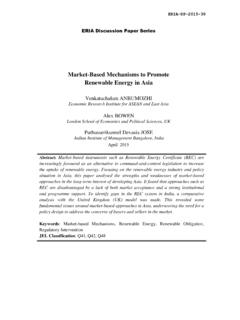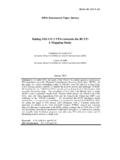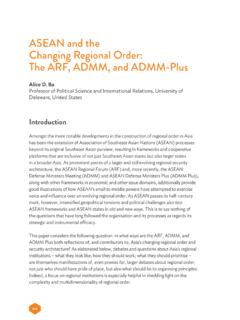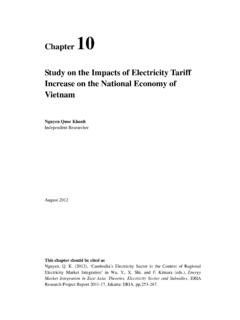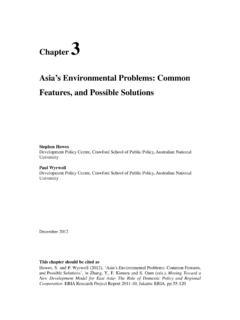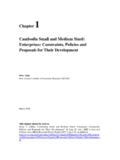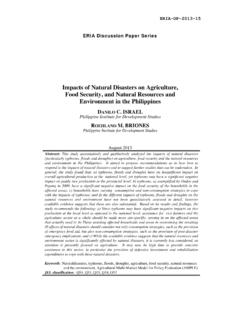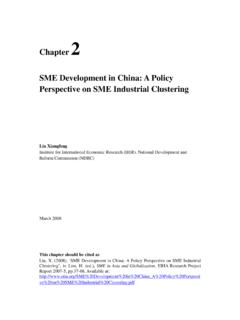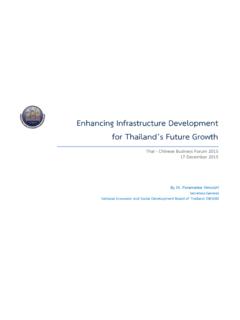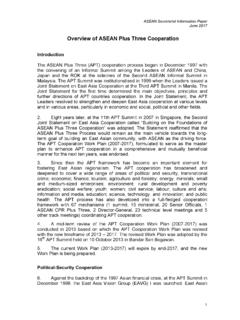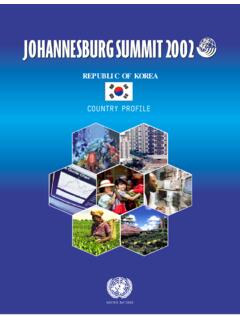Transcription of Ensuring ASEAN’s Sustainable and Resilient Future
1 309 Ensuring asean s Sustainable and Resilient FutureVenkatachalam AnbumozhiSenior energy Economist, Economic Research Institute for asean and East AsiaThe Association of Southeast Asian Nations ( asean ), now in its 50th year, has dazzled the world with its robust economic growth over the past 3 decades, reducing poverty rates and delivering middle-income comforts to millions. But the region is also struggling to manage the unwelcome byproducts of traditional development reduced air and water quality, depleted natural resources, and imperilled biodiversity which are exacerbated by an increasing frequency of disasters and a changing climate. But transition changes also arrived when asean Member States (AMS) agreed on blueprints for three community pillars the asean Political Security Community (APSC), the asean Economic Community (AEC), and the asean Socio-Cultural Community (ASCC), which all recognise the importance of Sustainable and Resilient development.
2 Using flexibility, trust, respect, and consensus the asean way AMS are pursuing a green recovery, even if it has meant a painful transition for some. This paper assesses the path travelled by asean on a sustainability front, and argues for further adjustments that are nuanced, context dependent, and modulated. An integrated collaborative framework is proposed to maximise, prioritise, and sequence the actions that derive different benefits from a Sustainable and Resilient Systems for Sustainability and ResilienceASEAN cooperation for sustainability and resilience is listed under all the three community pillars, which have an extensive list of issues, though with varying levels of details and focus. There are strategic objectives for each area followed by actions, which are a combination of policies, programmes, and projects. Actions in the blueprint are not only generally agreed statements, but are some sort of informal monitoring mechanisms at regional level as progress has to be reported regularly and provide the basis for coordinating work across sectors and countries under each community.
3 310 asean @30 Volume 9 | Building asean Community: Political Security and Socio-cultural ReflectionsThe community councils coordinate work under each pillar. Whereas the sustainability agenda is straightforward for AEC and APSC, it is a challenge for the ASCC, as there are many sectors of cooperation under sustainability and social inclusion competing for attention and asean approach to regional cooperation for sustainability has differed from that adopted in Europe, where legal and economic mechanisms were created and institutionalised at the intergovernmental and supranational levels. Those mechanisms require European Union members to give up some of their sovereignty on issues like water quality, air pollution, disaster responses, and climate change mitigation. asean institutions, on the other hand, are strictly intergovernmental. It started in the 1970s, as an expert group under the asean Committee on Science and Technology.
4 In addition to monitoring the progress of work by various groups in 10 specific areas under asean environmental cooperation, the environmental management framework also monitored sustainability provisions of asean legal instruments, such as energy trading and natural resource management, in many sectors of operation. asean s senior officials carry out series of activities such as preparing for asean s regional participation in international deliberations; establishing guidelines pertaining to ozone depleting emissions, pollution, biodiversity, climate change, forests, and related environmental matters; and working towards harmonisation of environmental standards for ambient and river water quality, electronic appliances, and impact regular preparation of the asean State of Environment Reports serves as the overall monitoring mechanism of sustainability in the region. There is no core asean environmental bureaucracy.
5 In each AMS, national focal points are responsible for carrying out asean initiatives. A summit of the asean heads of state and governments, asean s highest decision-making body, is held regularly. These high-level panels pave the way for ministerial-level meetings, and provide proposals for decisions to be discussed by senior level officials and adopted by consensus at the sectoral level. These meetings can also prepare for asean s regional participation in international deliberations on sustainability and resilience. The emphasis on trust and consensus is always reflected in the decisions. AMS agree on common sustainability and resilience measures, decide how to implement them, and contribute according to their capacities and capabilities, acknowledging that asean has achieved different levels of development and therefore has differing capacities for action. Trust and non-interference and a preference for national implementation of programmes rather than reliance on strong region-wide bureaucracy the asean way are always reflected in environmental asean s Sustainable and3 Resilient FutureInterdependent and Inseparable Chain of ChallengesThe asean way of regional environmental governance has enabled AMS to build mutual trust and confidence, and has progressed at a pace comfortable for all.
6 Nevertheless, as environmental and disaster related risks are becoming more complex and complicated, asean is facing new challenges when it knits together programmes across three community pillars. Further asean mandates of cooperation for sustainability should expand in tandem with global mandates, as reflected by new regimes like the Sustainable Development Goals (SDGs), the Paris Climate Agreement on Nationally Determined Contributions (NDCs), and the Sendai Frameworks for Disaster Risk concerns in asean are increasing, particularly because economic growth in many of the AMS remains fuelled by energy -intensive carbon emitting production and polluting industries. As asean continues to propel economic dynamism, its demand for energy will increase accordingly. The challenge is to achieve an orderly accelerated and affordable transformation towards growth that involves lower carbon emissions and Sustainable management of natural resources.
7 asean s growth is also leading to rapid and often unplanned urbanisation and motorisation, which add to the region s sustainability challenges. Many of asean s major urban centres have unacceptably poor air s water bodies including major rivers and their tributaries are also under stress. The discharge of untreated waste and pollutants from households, agricultural fields, industries, and townships contributes to the spread of waterborne diseases and is a major public health care issue for low-income households. The region s environmental problems are increasingly caused by factors that cut across national borders. For example, haze caused by forest fire is a common occurrence in some AMS. Brown clouds that cover some of the AMS are caused by pollutants released by the burning of fossil fuels and rural biomass across the region. The unsustainable harvesting of marine resources that are shared by several countries is often a source of , historically the asean region has been prone to greater hazards, big and small, that have resulted in many losses of lives and properties.
8 Its geographical location makes AMS more vulnerable to typhoons, floods, landslides, and storm surges. Earthquakes, tsunamis, and volcanic eruptions are common occurrences as the region lies at the intersection of four tectonic plates. Forest fires are also common and epidemics such as severe acute respiratory syndrome (SARS) and influenza A (H1N1, aka swine influenza) caused havoc and hardship amongst the populations affected. 312 asean @30 Volume 9 | Building asean Community: Political Security and Socio-cultural ReflectionsThe Middle East respiratory syndrome (MERS) and the Ebola and Zika viruses are major scares and they pose threats to the region given the number of asean migrant workers in affected parts of the change-induced events are likely to exacerbate these sustainability and resilience challenges. Recent assessments have found that climate change is likely to diminish continued progress on regional food security through production disruptions, leading to local availability limitations for households and price increases, diminished water availability, and health and safety issues.
9 The risks are greatest for the poor in the coastal regions. The economic impacts of all disasters and climate change are so immense that it is affecting the region more than any part of the world (World Bank, 2012). Current Pathways towards a Sustainable and Resilient asean Notwithstanding the evident need within asean countries to devote greater attention to implementation of shared policies, asean has been remarkably successful in shaping a common policy framework for sustainability and resilience. Region-wide agreements have been reached in the following areas:(1) Natural Resources and Biodiversity(a) Nature conservation(b) Heritage Parks and Protected areas(c) Sea Turtle Conservation and Protection(d) Convention on International Trade in Endangered Species(e) Heart of Boreno Initiation on Eco-systems(f) asean Center for Biodiversity(2) Forestry, Agriculture, and Food Security(a) Trans-boundary pollution(b) Forest law enforcement and governance(c) Food security(3) Cultural Heritage(4) Coastal and Marine Environment(5) Water Resource Management(6) Health (a) Severe Acute Respiratory Syndrome(b) Avian Influenza(c) Swine Influenza313 Ensuring asean s Sustainable and3 Resilient Future (7) energy and Climate(a) asean Petroleum Security Agreement(b) Agreement on asean energy Cooperation(c) Trans- asean Gas Pipeline(d) asean Plan of Action for energy Cooperation (e) Cebu Declaration on energy Security(f) Singapore Declaration on Climate Change(g)
10 Green Cities(8) Minerals(a) asean Mineral Action Cooperation Plan(b) Manila Declaration on Intensifying asean Minerals Cooperation(9) Disaster Management(a) asean Agreement on Disaster Management and Response(b) asean Coordinating Center for Humanitarian Assistance on Disaster Management(c) asean Disaster Management Training Institute Network(d) asean Disaster Management and Monitoring and Response System(10) Environmental Education(a) asean Environmental Education Action PlanLeadership and shared vision have been fundamental to the development of such coordinated programmes and the political leaders of asean should be congratulated for recognising the need for change and taking cooperative steps towards Sustainable and Resilient development, which could be replicated in other sub-regions. asean is remarkably efficient at making diverse cultures and political traditions share a common vision and pragmatic policies, within the region and from the region to global community.
